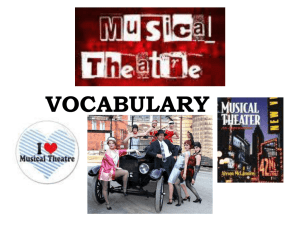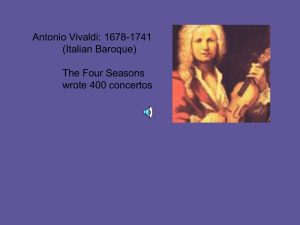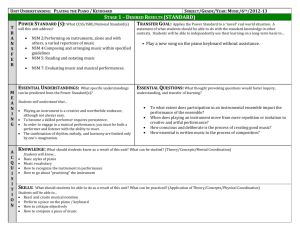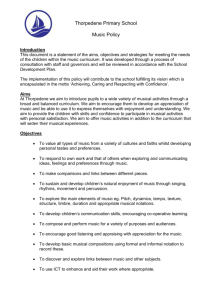EXAMINATION NUMBER 00766000 1. If you`re studying the science
advertisement
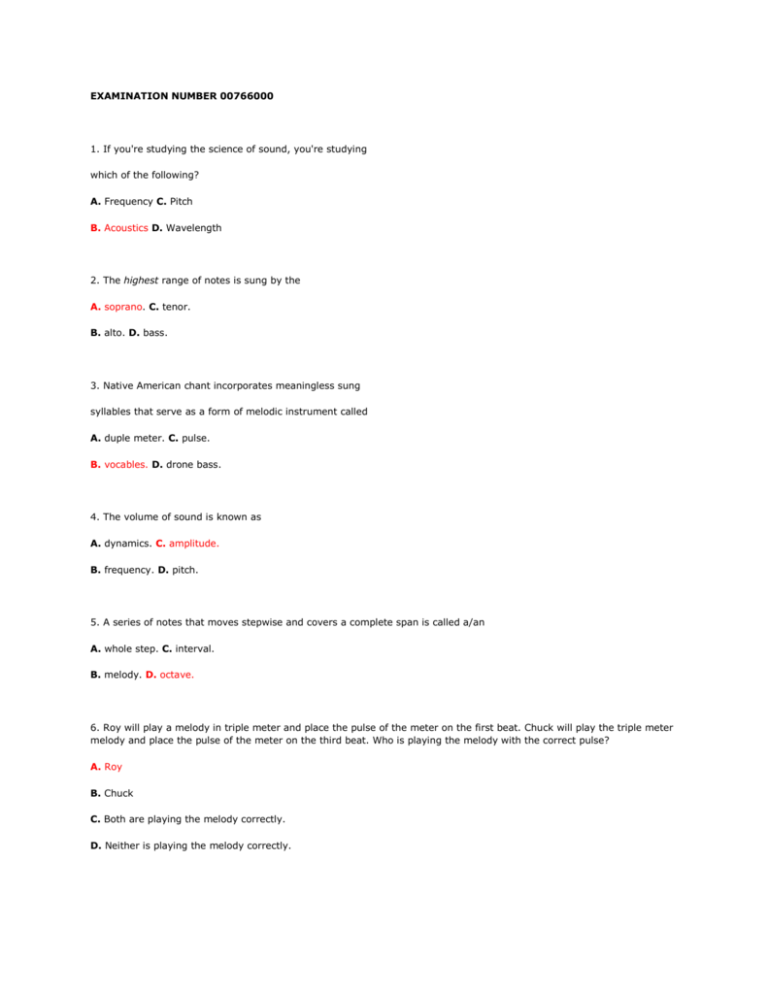
EXAMINATION NUMBER 00766000 1. If you're studying the science of sound, you're studying which of the following? A. Frequency C. Pitch B. Acoustics D. Wavelength 2. The highest range of notes is sung by the A. soprano. C. tenor. B. alto. D. bass. 3. Native American chant incorporates meaningless sung syllables that serve as a form of melodic instrument called A. duple meter. C. pulse. B. vocables. D. drone bass. 4. The volume of sound is known as A. dynamics. C. amplitude. B. frequency. D. pitch. 5. A series of notes that moves stepwise and covers a complete span is called a/an A. whole step. C. interval. B. melody. D. octave. 6. Roy will play a melody in triple meter and place the pulse of the meter on the first beat. Chuck will play the triple meter melody and place the pulse of the meter on the third beat. Who is playing the melody with the correct pulse? A. Roy B. Chuck C. Both are playing the melody correctly. D. Neither is playing the melody correctly. 7. The texture of Gregorian chant is said to be A. heterophonic. C. polyphonic. B. homophonic. D. monophonic. 8. Harmony is used to support the melody by using A. chords. C. meter. B. monophonic chant. D. tonic. 9. When a composer sets a single syllable of a word to several notes of music, he or she is using _______ style. A. plainchant C. melismatic B. syllabic D. cadence 10. An example of a double reed musical instrument is the A. bassoon. C. saxophone. B. clarinet. D. piccolo. 11. In plainchant, a sentence of text almost always ends with A. cadence. C. a minor chord. B. disjunct motion. D. the note D. 12. Landini's tendency to intersperse occasional melismas in text that was generally syllabic in nature helped to ensure that the music A. was easily understood by the listener. C. wasn't monotonous. B. conveyed happiness. D. had enjoyable rhythm. 13. Until the sixteenth century, music was written primarily A. in the minor mode. C. in the major mode. B. for just one voice. D. for dance. 14. The basic framework for ordering music through time is the A. value. C. syllable. B. phrase. D. meter. 15. In musical language, mezzo forte (mf) signals that the music's volume should be A. medium soft. C. soft. B. very loud. D. medium loud. 16. What invention during the Renaissance period enabled people to purchase music for their own personal use? A. Faster delivery service B. Printing press C. Instruments for trained transcription workers D. Electronic recording devices 17. Von Bingen's Play of Virtues is set to which of the following types of music? A. Madrigal C. Liturgical plainchant B. Orchestral D. Harmonic 18. An example of a percussion instrument is the A. lute. C. shawm. B. drum. D. violin. 19. A capella choral music is meant to be A. sung by men only. B. sung by women only. C. played in church on an organ. D. sung without instrumental accompaniment. 20. A measured performance that adheres consistently to the duple meter would be read as A. 1-2-3-4. C. 1-2-3. B. 1-2-3-4. D. 1-2-3-4. The Baroque Era EXAMINATION NUMBER 00766100 1. A lyrical movement or piece for solo voice with instrumental accompaniment is called a/an A. ostinato. C. operetta. B. aria. D. chorus. 2. What is the difference between an oratorio and an opera? A. An opera is staged and an oratorio isn't. B. An oratorio doesn't include an aria and an opera does. C. The opera is based on a sacred topic and an oratorio isn't. D. An oratorio doesn't include recitatives. 3. The first opera to win widespread acclaim was A. Purcell's Dido and Aeneas. B. Handel's Messiah. C. Monteverdi's Orpheus. D. Handel's Rinaldo. 4. The use of two violins and a basso continuo forms which combination of music? A. sonata da chiesa. C. sonata da camera. B. cantata. D. trio sonata. 5. Instrumental work written for a soloist and a larger ensemble is called a A. concerto. C. prelude. B. cantata. D. fugue. 6. All of the following instruments would be likely to play the basso continuo in a Baroque musical piece except the A. lute. C. cello. B. harpsichord. D. violin. 7. Handel's Messiah is classified as a/an A. oratorio. C. cantata. B. chorale. D. opera. 8. When instruments double the voices by playing the same notes sung by a chorus, the music is considered to have A. unified timbre. C. syncopation. B. paired movement. D. contrasting timbre. 9. The Baroque period began around the year A. 1050. C. 1600. B. 1500. D. 1750. 10. The main theme of a fugue is called the A. exposition. C. episode. B. melody. D. subject. 11. The last movement of Bach's Cantata no. 140 is what texture? A. Polyphonic C. Atonal B. A ritornello D. Homophonic 12. A style of vocal music that's a cross between singing and speaking is commonly referred to as A. pavane. C. recitative. B. polychoral. D. gigue. 13. Music work performed in a series is called a/an A. suite. C. fugue. B. sonata. D. allemande. 14. The most popular oratorio is A. Der Messias. C. Orpheus. B. Messiah. D. Aeneas. 15. The _______ is a musical form that utilizes multiple soloists. A. sarabande C. chorale prelude B. concerto grosso D. Gothic motet 16. The musical instrument referred to as the "King of Instruments" is the A. human voice. C. tuba. B. violin. D. organ. 17. Another word for "round" is A. canon. C. gigue. B. rhapsody. D. sarabande. 18. The form of the melody called the bar form is represented by A. AAB. C. ABA. B. ABB. D. ABBA. 19. Handel's first operatic hit, which premiered in London in 1711, was A. Saul. C. Four Seasons. B. Rinaldo. D. Giulio Cesare. 20. A _______ performance usually requires the musicians to embellish the part written for them. A. virtuoso C. passacaglia B. transcripted D. canzona The Classical Era EXAMINATION NUMBER 00766200 1. The second section of a sonata is commonly called the A. development. C. coda. B. codetta. D. recapitulation. 2. The double exposition concerto form differs from the standard sonata form in that A. it includes a single exposition. B. it's played by two pianos. C. it has a cadenza. D. the exposition stays in the same key. 3. Which one of the following patterns represents the rondo form? A. A B A C A C. A B C D B. A A B B C D. D C B A 4. Which of the following is a long work for orchestra, usually made up of four movements? A. Concerto C. Symphony B. Sonata D. Opera 5. The dialogue in an opera is translated for the audience in the A. score. C. paggio. B. perdonate. D. libretto. 6. The Japanese koto is what type of instrument? A. Wind C. Percussion B. String D. Brass 7. Opera _______ is a light, frequently comic style of opera. A. buffa C. hysteria B. seria D. canonica 8. The _______ is an essential characteristic of the sonata form. A. sudden crescendo C. fluctuation of rhythm B. absence of harmony D. development of themes 9. In a string quartet, the bass instrument is the A. drum. C. viola. B. cello. D. bass guitar. 10. A musical piece written in the sonata form closes with the A. tonic. C. coda. B. codex. D. antecedent. 11. Singing the alphabet song to the tune of Mozart's "Ah, vous dirai-je, maman" is an example of A. plagiarism. C. musical appropriation. B. musical duplication. D. thematic variation. 12. The first section of a sonata in which the theme is presented is commonly called the A. recap. C. exposition. B. allegro. D. prodigy. 13. A courtly dance in triple meter, with the accent on the first beat of each measure, was the A. gavotte. C. bouree. B. minuet. D. rondo. 14. When the Italian words da capo appear at the end of a measure, the musician is being instructed to A. hold the notes for an extra three beats. B. play the main part of the musical piece over again. C. play the refrain. D. play the next part of the music quietly. 15. What dates are commonly assigned to the Classical period? A. 1650-1720 C. 1700-1800 B. 1700-1750 D. 1750-1800 16. A soloist can display his virtuosity to the fullest during the A. cadenza. C. concerto. B. capo. D. cadence. 17. Which one of the following pieces of music would you most expect to be played by a full orchestra? A. Chamber music C. Symphony B. Minuet D. Concerto 18. In a sonata form selection, the theme is presented in the A. exposition. C. recapitulation. B. tonic or home key. D. development. 19. Which mid-eighteenth century composer is credited with having the greatest impact on the significance of the string quartet? A. Haydn C. Chopin B. Beethoven D. Mozart 20. In an opera, the standard accompaniment for a recitative is A. played by the orchestra. C. sung by a soprano. B. a function of the string quartet. D. the basso continuo alone. The Nineteenth Century, Part 1 EXAMINATION NUMBER 00766300 1. A poem that tells a story is called a A. chorale. C. limerick. B. ballad. D. stanza. 2. Symphonie fantastique, which depicts an artist's execution by guillotine, was written by the nineteenth century composer A. Caspar David Friedrich. C. Erlkönig. B. Berlioz. D. Giacchino Rossini. 3. The piano became a popular instrument for middle-class families when A. Dvorak composed The American. B. the Transcontinental Railroad was completed. C. mass production became possible. D. the Civil War ended. 4. A Midsummer Night's Dream, William Shakespeare's play about the collision of reality and fantasy, was captured in a musical piece by A. Felix Mendelssohn. C. Franz Schubert. B. Hector Berlioz. D. Ludwig van Beethoven. 5. Franz Schubert was known for having written A. 100 violin concertos. C. four operas. B. 11 symphonies. D. 144 lieder. 6. In his Fifth Symphony, Beethoven A. limits the harmony of the string section. B. contrasts the wind instruments with the string instruments. C. utilizes the percussion section in a whole new way. D. introduces the short-LONG-short-LONG rhythm. 7. Clara Wieck Schumann's "Forward!" was written for a/an A. a capella chorus. C. full orchestra. B. brass band. D. madrigal choir. 8. A piano trio is made up of A. three pianos. C. a piano, organ, and pianoforte. B. a piano, violin, and cello. D. a piano, violin and viola. 9. Berlioz insisted that a _______ be distributed to his audiences to provide an overview of the dramatic structure of his work. A. libretto C. program B. musical score D. Transcript 10. Prolonged exposure to volume greater than _______ is considered dangerous. A. 40 decibels C. 70 decibels B. 50 decibels D. 80 decibels 11. Which of the following was not one of the obstacles Fanny Hensel had to overcome as a composer? A. Agoraphobia kept her from traveling and performing. B. Her brother was a famous composer and performer. C. Her father discouraged her from pursuing music as a vocation. D. Social attitudes prevented women from undertaking careers in music. 12. Which of the following works helped to redefine the symphony as a genre? A. Symphonie fantastique B. Beethoven's Fifth Symphony C. Beethoven's Sixth Symphony D. Beethoven's Ninth Symphony 13. _______ music is generally associated with nonmusical ideas and objects. A. Character C. Recital B. Program D. Literary 14. Which composer called himself a tone poet-a poet who creates with music rather than words? A. Beethoven C. Schubert B. Schumann D. Chopin 15. Influenced by Dvorak, _______ is credited as the first American woman to have written a symphony. A. Clara Wieck Schumann C. Amy Marcy Cheney Beach B. Fanny Mendelssohn Hensel D. Louise Farrenc 16. In 2001, the President of Turkmenistan banned A. all music. C. rock music. B. jazz. D. ballet and opera. 17. The overture to A Midsummer Night's Dream is a one-movement work A. in sonata form. B. famous for the interplay of piano, violin and cello. C. known for the massive sound of the orchestra. D. that presents the same basic musical idea in each strophe of the text. 18. _______ was called the "Valkyrie of the Piano." A. Fanny Mendelssohn Hensel C. Robert Schumann B. Clara Wieck Schumann D. Teresa Carreno 19. The composer utilized the minor mode in Symphonie fantastique to represent A. solemnity and brilliance. C. gloom and ferocity. B. joy and love. D. earthiness. 20. In the overture to A Midsummer Night's Dream, the kingdom of the fairies, led by Oberon and Titania, is represented by the A. strings. C. flute. B. piccolo. D. triangle. The Nineteenth Century, Part 2 EXAMINATION NUMBER 00766400 1. The styles of singing in Wagner and Verdi operas differ. Jane says that the style of singing in a Verdi opera is virtuosic and elaborate. Lynn says that the style of singing in a Wagner opera is more syllabic. Who is correct in describing the different styles of singing? A. Only Jane is correct. B. Only Lynn is correct. C. Both Jane and Lynn are correct. D. Neither Jane nor Lynn is correct. 2. Which one of the following musical notations allows performers to improvise slightly with the rhythm? A. Sostenuto C. Allegretto B. Moderato D. Rubato 3. Why was Richard Wagner considered the most progressive composer of his day? A. He combined choral music and orchestral music. B. He introduced the libretto to the opera. C. He advanced the harmonic idiom of music into new, exciting realms. D. He used the tala pulses in his orchestrations. 4. In response to the outbreak of the Civil War, which composer wrote a solo piano piece that incorporated the "Star Spangled Banner," "Hail Columbia," and "Yankee Doodle" into the work? A. Gottschalk C. Mendelssohn B. Brahms D. Dvorak 5. In Verdi's La Traviata, Violetta sings _______ when unsure of herself. A. an aria C. in recitative B. a virtuoso D. in a lower key 6. To show his intense national pride, _______ wrote a large number of mazurkas. A. Verdi C. Shankar B. Chopin D. Dvorak 7. During the nineteenth century, harmony became A. more discordant. B. a large-scale structural element. C. more chromatic. D. highly important in program music. 8. The third movement of Dvorak's "String Quartet in F Major" contains a light-hearted passage in a fast tempo and in triple meter called a A. variation. C. rondo. B. prelude. D. scherzo. 9. Ravi Shankar is known for his mastery of the 18-stringed lute called the A. ragar. C. jhala tar. B. sitar. D. table. 10. The _______ measures musical time using a pendulum. A. metronome C. intermezzo B. lyre D. timbrephone 11. A single pair of notes played repeatedly in succession is known as a/an A. a capella. C. hee haw. B. drone bass. D. sotto voce. 12. Wagner drew on _______ for his opera The Ring of the Nibelungs. A. religious dogma C. Greek mythology B. Roman mythology D. northern European mythology 13. The various melodies heard in "Dvorak's String Quartet in F Major" have a/an _______ quality. A. jazz-like C. folk-like B. Bach-like D. operetta 14. Which of the following composers helped the United States establish its own musical sound by drawing on cultural idioms? A. Brahms C. Dvorak B. Wagner D. Verdi 15. Which composer is thought to epitomize Romanticism? A. Dvorak C. Gottschalk B. Chopin D. Schumann 16. The first American-born piano virtuoso to achieve international fame was A. Dvorak . C. Schumann. B. Wagner. D. Gottschalk. 17. _______ exemplifies the best elements of nineteenth-century Italian opera. A. La Boheme C. Rigoletto B. Pagliacci D. La Traviata 18. Compared to a violin, a cello has a _______ register. A. low C. high B. calm D. baudy 19. In Brahms' Symphony no. 4 in E Minor, the composer derived much of the form and theme from the A. music of the middle ages. C. Classical era. B. Baroque era. D. music of the Renaissance. 20. Which opera was written to celebrate the opening of the Suez Canal? A. Aida C. Il Trovatore B. Rigoletto D. Requiem The Twentieth Century, Part 1 EXAMINATION NUMBER 00766500 1. The Rite of Spring was composed by A. Arnold Schoenberg. C. Heitor Villa-Lobos. B. Igor Stravinsky. D. Alban Berg. 2. Jody says that atonal harmony establishes a harmonic center of gravity. Sean says that atonal harmony doesn't have a harmonic center of gravity. Who is correct? A. Only Jody is correct. B. Only Sean is correct. C. Both Jody and Sean are correct. D. Neither Jody nor Sean is correct. 3. _______ music is written in two or more chords played simultaneously. A. Polytonal C. Polyphonic B. Polyrhythmic D. Polychoral 4. The _______ style is an attempt to revive the approach used by composers in the latter half of the eighteenth century. A. Pre-romantic C. Neo-classical B. New Baroque D. Post-modern 5. _______ is a singing technique that's part speech and part song. A. Sprechstimme C. Klangfarben B. Walkurie D. Erlkönig 6. Music that doesn't center on a particular key is referred to as A. intoned. C. nontonal. B. untoned. D. atonal. 7. Modernism, a movement that represented an abolishment of tradition and a quest for novelty, took place when? A. Middle nineteenth century C. Classical period B. Early twentieth century D. Early twenty-first century 8. Bebop is a style of A. jazz. C. fusion. B. pop. D. ragtime. 9. Ragtime composers often made use of A. counterpoint. C. syncopation. B. inversion. D. serialism. 10. _______ notes are produced by lowering the third, fifth, or seventh steps of major scales. A. Low C. Minor B. Falsetto D. Blue 11. Roland says that Ruth Crawford Seeger was a modernist composer. Clive says that she was a collector and arranger of American folksongs. Who is correct? A. Only Roland is correct. B. Only Clive is correct. C. Both Roland and Clive are correct. D. Neither Roland nor Clive is correct. 12. _______ used themes from popular songs and hymns in his orchestral works. A. Scott Joplin C. Duke Ellington B. Charles Ives D. Igor Stravinsky 13. Expressionist music is generally thought of as A. happy. C. probing. B. extravagant. D. bouncy. 14. Which of the following composers sought to obtain a non-percussive sound from the piano in his compositions? A. Glass C. Ives B. Debussy D. Ellington 15. Schoenberg's 12-tone composition is based on a/an _______ scale. A. minor C. pentatonic B. major D. chromatic 16. The _______ were interested in the hypnotic quality of the repeated melodic fragments and interlocked patterns created by the gamelan. A. expressionists C. minimalists B. impressionists D. neo-classicists 17. The smallest distance between two adjacent notes on a piano is a A. whole note. C. quarter note. B. half step. D. whole step. 18. In The Unanswered Question, the strings are played A. as if they're playing a slow hymn. B. in unresolved dissonance. C. fast and loud for shock value. D. in constant competition with the brass. 19. The most common pattern of verses in blues songs is the A. 12-bar pattern. C. 8-note pattern. B. 6-bar pattern D. 28-note pattern. 20. Standard Song Form for popular hits of the 1920s and 1930s was A. ABA. C. ABBA. B. AABB. D. AABA. The Twentieth Century, Part 2 EXAMINATION NUMBER 00766600 1. Which one of the following composers is best known for promoting aleatory music? A. John Cage C. Franz Wozzek B. Richard Strauss D. Béla Bartók 2. Which of the following composers wrote the music for West Side Story? A. George M. Cohan C. Jerome Kern B. Leonard Bernstein D. Cole Porter 3. Tamra says that the difference between an opera and a musical is that the opera includes more spoken word than singing. Eduardo says that the musical contains singing with some spoken dialog. Who is correct in citing the difference? A. Tamra B. Eduardo C. Both Tamra and Eduardo D. Neither Tamra nor Eduardo 4. The first African American to have a major opera performed by a major American opera company was A. Scott Joplin. C. Langston Hughes. B. William Grant Still. D. Robert Johnson. 5. The _______ is a xylophone-like instrument with tubular resonators under each bar. A. conga C. timbales B. marimba D. suspended cymbal 6. Public Enemy's abrasive rap recording "Fight the Power" has a basic pulse of A. 60 beats per minute. C. 106 beats per minute. B. 86 beats per minute. D. 120 beats per minute. 7. For the movie Crouching Tiger, Hidden Dragon, Chinese-American _______ was enlisted to play the cello to offset the Asian-sounding erhu. A. Tan Dun C. Ang Lee B. Xiaohui Ma D. Yo-Yo Ma 8. The musical movement that started in the mid-1960s on the West Coast was the _______ movement. A. folk C. psychedelic B. rock D. progressive 9. The progression of four basic chords that was used in many popular songs of the 1950s and 1960s is referred to as _______ chord progression. A. bebop C. doo-wop B. pop D. Vamp 10. Notes that begin a phrase before a downbeat are known as pick-up notes or a/an A. duck walk. C. shuffle groove. B. call and response. D. anacrusis. 11. Einstein on a Beach was a unique opera because it A. had no plot and very little singing. C. had a single violinist. B. was written in Chinese. D. was exclusively recitative. 12. Agnes de Mille choreographed Aaron Copland's Rodeo to blend A. ballet with tap. C. square dance with Irish jig. B. jazz and ballet. D. ballet with square dance. 13. Which song crossed racial boundaries by achieving success on both the R&B and pop charts? A. "Please Mr. Postman" C. "Fight the Power" B. "School Day" D. "My Ding-a-Ling" 14. A musical style that combines traditional and modern elements is called A. exhibitionism. C. postmodernism. B. modernism. D. minimalism. 15. A repeated melodic and rhythmic figure in the lower register of the piano is typical of the Afro-Cuban dance music known as A. mambo. C. salsa. B. guaguanco. D. reggae. 16. The musician who ushered in the twentieth-century era of virtuosic rock guitar playing was A. Chet Atkins. C. Chuck Berry. B. Jimi Hendrix. D. Brian Wilson. 17. A modern-day retelling of Shakespeare's Romeo and Juliet is carried out in the musical A. H.M.S. Pinafore. C. My Fair Lady. B. The Mikado. D. West Side Story. 18. Which of John Cage's works has been perceived by some as a joke? A. Einstein on a Beach C. Illiac Suite B. Imaginary Landscape no. 4 D. 4'33'' 19. The type of music that blended the musical styles of jump blues and honky-tonk was A. Motown. C. jazz. B. rock 'n' roll. D. hip hop. 20. The hand-clapping at the beginning of the song "Please Mr. Postman" is known as the A. hook. C. shuffle groove. B. ostinato. D. vamp.
